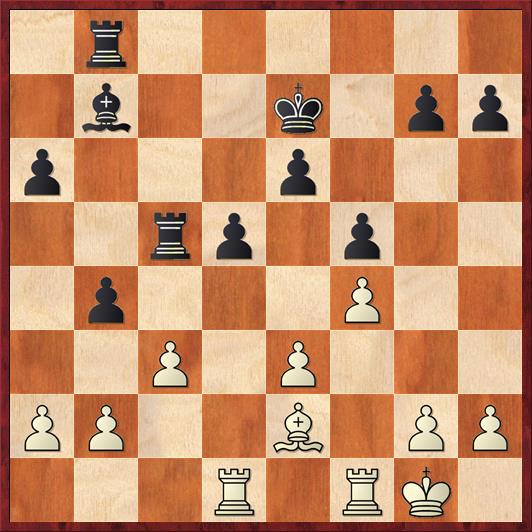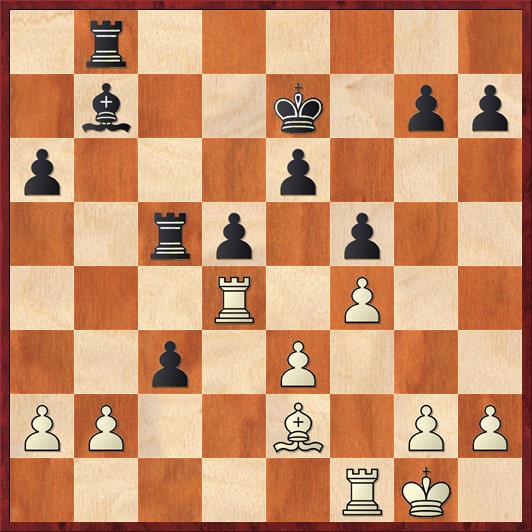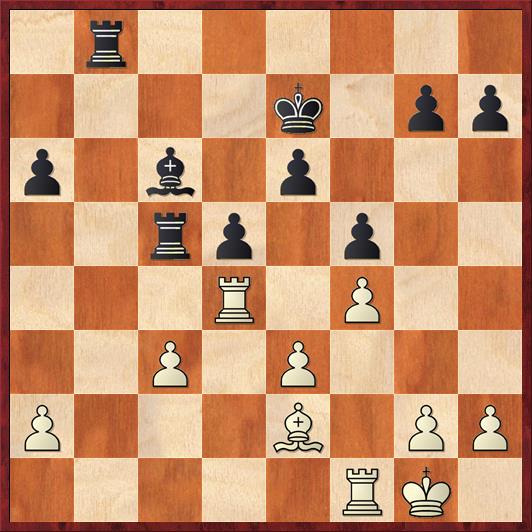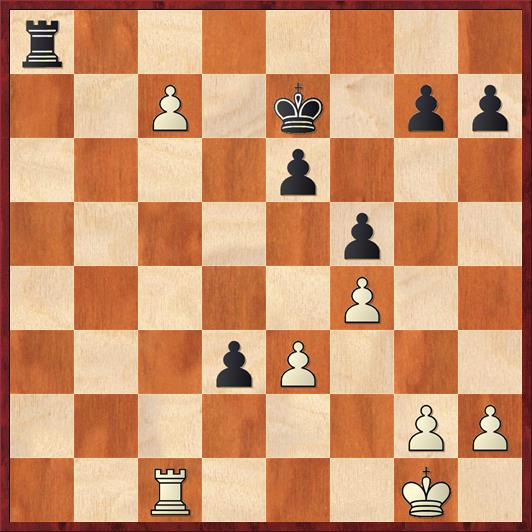I’d like to show you a position from my one loss in the U.S. Amateur Team tournament. It came in round two against Neel Apte. Although I hadn’t played him before, I consider him sort of a “classmate,” because there are three or four Bay Area kids who cracked the 2200 barrier at just about the same time that I (re-)cracked it. Of course he’s 17 and I’m 57, so we’re not exactly classmates in the chronological sense.
Neel played a very good and opportunistic game, seizing on little tactical opportunities that I kept overlooking. On my side, I feel as if the game shows a little bit of rust (it was my first tournament game after a five-month layoff).
There was one position that I found really interesting, because it’s a case where neither of us completely understood what was going on at first, and it’s amusing to watch us gradually figure it out.
 Position after 20. … b4. White to play.
Position after 20. … b4. White to play.
FEN: 1r6/1b2k1pp/p3p3/2rp1p2/1p3P2/2P1P3/PP2B1PP/3R1RK1 w – – 0 21
Neel has just played 20. … b4, which I think was a good move because it put me on the spot. I hadn’t been expecting it (as I said, I was rusty), and with a certain amount of disbelief I realized that after 21. cb? Rc2 I am losing a pawn in all variations. For instance, 22. Bd3 Rxb2 22. a3 Rb3 and I can’t defend a3 because the bishop hangs. Or 22. Bf3 Rxb2 23. a3 Rb3 with a fork. Or 22. Rf2 Rxb2 23. a3 Rc8! 24. Bf1 Rb3 25. Rd3 R8c3.
I actually did figure out the right move, though, as well as half of the right idea. I finally realized that I could play 21. Rd4! After this move an interesting situation arises where neither side wants to trade pawns. I don’t want to trade pawns because it opens the c-file for his rook to invade on c2. He doesn’t want to trade pawns because it opens the b-file and I can get a very dangerous pin.
I don’t think Neel quite realized this at first, because he played 21. … bc?!, which is a misstep but a survivable one. I think it would be better for him either to break the potential pin immediately, with 21. … Bc8, or else to prevent my rook from reaching the b-file with 21. … a5! The second line in particular could lead to very tricky play, if I play 22. cb?! (I don’t think this is best) Rc2 23. ba!? (diagram)
 Position after 23. ba (analysis). Black to move.
Position after 23. ba (analysis). Black to move.
FEN: 1r6/1b2k1pp/4p3/P2p1p2/3R1P2/4P3/PPr1B1PP/5RK1 b – – 0 23
White offers a piece sac, but Black should not accept it! If 23. … Rxe2? 24. Rb4 White will win the piece back with a6, with a clear advantage. Instead Black should take the pawn! 23. … Rxb2! 24. a6 Bc6 25. Rf2 Rxa2 26. Bd3 leads to a position where, in my opinion, Black is better but White may be just barely hanging on.
Going back to the first diagram, after 21. Rd4! a5! I think that White should play 22. Rb1! More shadowboxing! White wants Black to be the one to take on c3. But of course, two can play this game. Black would reply 22. … Bc6! “No! You take the pawn! I insist!” And indeed, White can’t avoid taking any longer, because of the pin on b2. Luckily, after 23. cb Black can’t play 23. … Rc2 because 24. Bd1 evicts the rook. So Black would probably play 23. … ab, and after 24. Rd2 I think that White has nothing to fear.
But of course none of this happened, because neither of us fully realized how crucial this battle over the b- and c-files was. As I said earlier, the game actually went 21. Rd4! cb?!
 Position after 21. … bc. White to move.
Position after 21. … bc. White to move.
FEN: 1r6/1b2k1pp/p3p3/2rp1p2/3R1P2/2p1P3/PP2B1PP/5RK1 w – – 0 22
Now we come to two really disappointing moves in a row for me. They’re disappointing because I had the right idea and didn’t follow through on it. Or I had only half of the right idea. Here I played 22. bc? almost immediately. I barely even thought about it, because I was so thrilled about his opening the b-file.
I’ve often said that my two most common mistakes are 1) the moves I spend the most time on, and 2) the ones I spend the least time on. In the former case, I am overthinking and usually talking myself out of making the move that should be made. In the latter case, I am playing by reflex, making assumptions without questioning those assumptions.
In particular, this phenomenon of the “automatic recapture” is something that all chess players have to watch out for. It is so deeply ingrained in our psychology, the even trade. I take you, you take me. Chop, chop. Sometimes you have to stop yourself between the “chop” and the “chop” and say, is there anything else? An in-between move?
And in this case, there is. It should have been obvious: 22. Rb4!, taking the b-file right away. That was the whole idea, right? I just didn’t think the idea through to its logical conclusion. Black is lucky to have a way to bail out to equality: 22. … a5 23. Rb6 c2 24. Rc1 Rcc8 25. Bd3 Bc6 26. Rxb1 Rxb1 27. Rxc2. Neil told me after the game that he was sweating bullets, wondering what he would do after 22. Rb4.
But after 22. bc he had the chance to atone for his earlier mistake and play 22. … Bc6! As simple as it is, this move nevertheless caught me by surprise, because in my analysis I was still in “automatic recapture” mode and expecting 22. … Rxc3??
 Position after 22. … Bc6. White to move.
Position after 22. … Bc6. White to move.
FEN: 1r6/4k1pp/p1b1p3/2rp1p2/3R1P2/2P1P3/P3B1PP/5RK1 w – – 0 23
Here I made one more mistake, which I think was completely due to psychology. As I’ve said, I had already faced a couple surprises, 20. … b4 and 22. … Bc6, and I just had the feeling that I was overlooking stuff. This does things to your confidence. So I talked myself out of playing the move I should have played and impulsively played 23. Bxa6? instead. After that, Black won a pawn with ease after 23. … Ra8 24. Bd3 Rxa2, and the c-pawn was indefensible.
I think that 23. Rb4 would at least offer me a chance of defending. The reason I didn’t play it was that I was still in the frame of mind that I couldn’t under any circumstances allow his rook to c2. But that’s not true any more. After 23. Rb4 Rxb4?! 24. cb Rc2 25. Bxa6 Rxa2 26. b5 we reach a very dicey endgame where I believe that White survives. After, say, 26. … d4 27. bc Rxa6 28. Rc1 d3 29. c7 Ra8, White just has to dodge an amusing trap. Do you see it?
 Position after 29. … Ra8 (analysis). White to move.
Position after 29. … Ra8 (analysis). White to move.
FEN: r7/2P1k1pp/4p3/5p2/5P2/3pP3/6PP/2R3K1 w – – 0 30
Here White must avoid 30. c8Q?? Rxc8 31. Rxc8 d2!, when White cannot stop the pawn from promoting. But on any other reasonable move, such as 30. Rd1, the game is dead even.
Going back to the previous diagram (diagram four), after 23. Rb4 I think Black should not trade rooks but should instead play 23. … Ra8, with the intention of torturing White over the long term with pressure on the isolated c-pawn. Clearly the position would be more fun for Black than for White, but at least I would have a somewhat better chance to defend than I did in the game.
To sum up, it’s amazing how much of this I didn’t see during the game and how much neither of us saw during our post-mortem. This just shows what a long, long way it is from 2200 to true mastery. The goal of a thinking chess player must not be to achieve a certain number, but to be able to look at a position like this and understand it.


